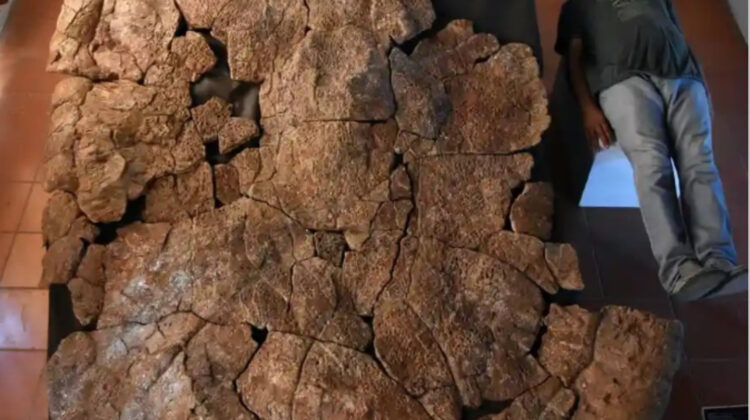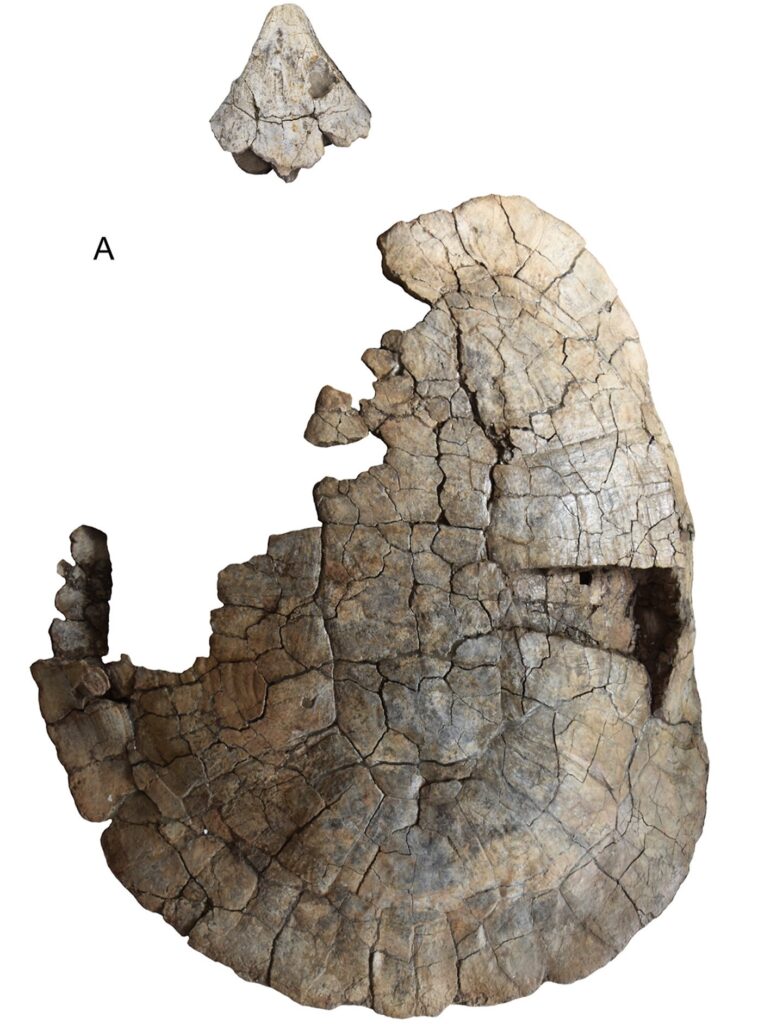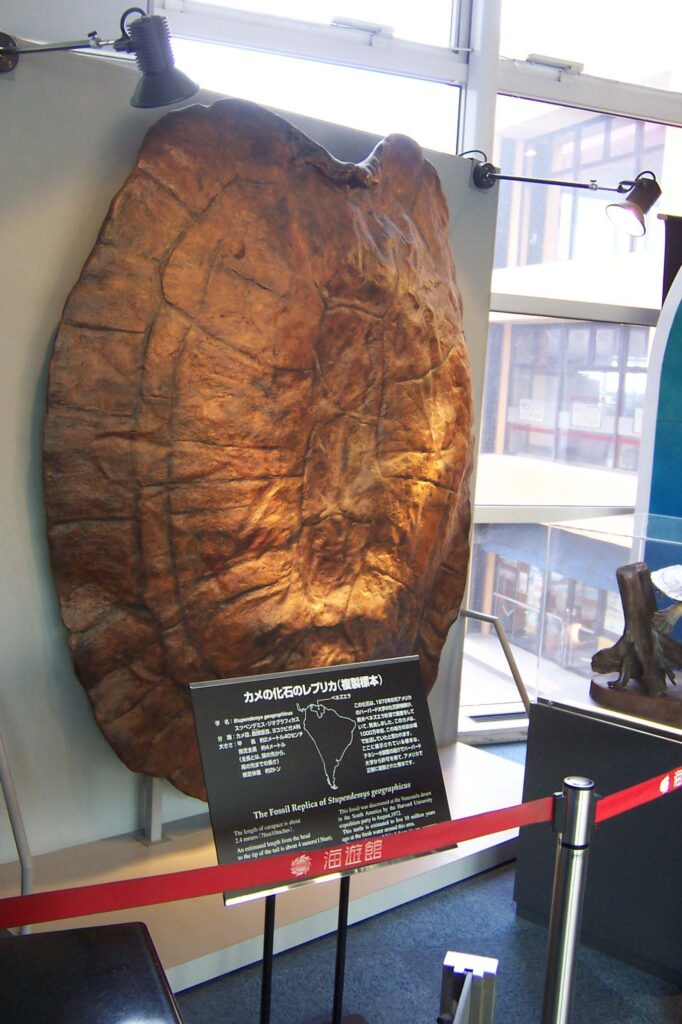
Stupendemys is an extinct genus of freshwater side-necked turtle, belonging to the family Podocnemididae. It is the largest freshwater turtle known to have existed, with a carapace over 2 meters long. Its fossils have been found in northern South America, in rocks dating from the Middle Miocene to the very start of the Pliocene, about 13 to 5 million years ago. In this article, we will explore the history, naming, and description of this incredible creature.

History and Naming
Stupendemys was first named in 1976 by Roger C. Wood based on specimen MCNC-244, the medial portion of a large-sized carapace with associated left femur, scapulacoracoid, and a cervical vertebra. Wood also described several other specimens he referred to Stupendemys, which includes MCZ(P)-4376. This specimen preserves much of the carapace alongside a fragmented plastron and various other bones. The fossils were unearthed by a paleontological excavation of Harvard University in Venezuela in 1972.
In 2006, a second species, Stupendemys souzai, was described by Bocquentin and Melo based on material from the Solimões Formation in Acre State in Brazil, also home to the giant Caninemys. In February 2020, Cadena and colleagues published a paper describing material discovered during the routine excavations in the Urumaco Formation, which have been ongoing since 1994. The material includes a relatively complete carapace that set a new maximum size for the genus and was designated as the allotype, meaning the specimen is of the opposite sex of the holotype.
Description

The skull of Stupendemys is roughly triangular in top view, and the edges of the jaws converge at the front of the snout in a straight edge. The skull is dorsally extremely inflated by the prefrontals that make up a large area of the front region of the skull, forming a vertical wall above the bony nostril. Following the prefrontals and orbits, the skull slopes down drastically before ascending again through the parietals. The orbits are relatively small and oriented to the sides.
When viewed from below, the premaxillae bear a deep concavity at their center. In this view, the premaxillae form most of the anteromedial edge of the skull, meeting each other towards the middle of the skull and narrowing just before the deep concavity. In front view, the premaxillae form the bottom margin of the bony nostrils, tapering as they move down.
The carapace of adult Stupendemys can reach a straight midline length of greater than 2 meters with a low-arched profile. The nodular contours on the surface are irregular, and the frontal margin of the shell is characterized by a deep notch flanked by large horns in male specimens. These horns are deeply grooved, suggesting that they were covered by a keratinous sheath. In addition to these horns, the front margin of the nuchal-peripheral bones is notably thickened and upturned. The surface is smooth to striated or lightly pitted. The margins of the posterior peripheral bones are moderately scalloped. The costal scutes of the carapace are relatively thin. In overall shape, the carapace of Stupendemys is longer than it is wide.
Size

Stupendemys is the largest known species of freshwater turtle currently known to science, with several specimens reaching over 2 meters (6.6 feet) in shell length and an estimated weight of more than 1,000 kg (2,200 pounds). Its size is comparable to that of a small car, and it likely had few predators in its environment due to its massive size. Its massive shell may have also served as protection from potential predators such as crocodiles and other large predators that lived in the rivers and lakes where it lived.
Behavior and diet
The bony horns on the front edges of the shells of male Stupendemys suggest that they may have engaged in intra-specific combat, possibly to establish dominance or mating rights. However, there is currently no direct evidence to support this hypothesis.
In 2021, a fossil skull of Stupendemys was discovered that revealed it to be a generalist feeder, meaning it likely consumed a variety of foods. The skull had a wide, flat palate, which is a characteristic of turtles that consume hard-shelled prey such as mollusks or crustaceans. The discovery of the young adult specimen also suggests that Stupendemys may have transitioned from a primarily carnivorous diet to an omnivorous one as it aged.
Habitat and distribution
Stupendemys fossils have been found in northern South America, in rocks dating from the Middle Miocene to the very start of the Pliocene, about 13 to 5 million years ago. The exact habitat and distribution of Stupendemys are difficult to determine from the fossil record alone, but it is believed that they lived in freshwater habitats such as rivers and lakes.
The discovery of Stupendemys fossils in multiple locations across northern South America suggests that the genus had a relatively wide distribution. However, the scarcity of Stupendemys fossils compared to other extinct turtles such as Carbonemys suggest that they may have been less abundant or less widely distributed than some of their contemporaries.
Relationship to other turtles
Stupendemys is a member of the family Podocnemididae, which includes a variety of extant and extinct freshwater turtles. The family is characterized by their unique method of withdrawing their head into their shell by folding their neck sideways. Stupendemys is thought to be closely related to the living Arrau turtle (Podocnemis expansa) and the extinct Carbonemys, which also inhabited northern South America during the same time period.
Stupendemys is distinguished from other podocnemidids by its large size, the presence of bony horns on male specimens, and its unique carapace shape.
Conservation status
As an extinct species, Stupendemys is not currently listed by any conservation organization. However, the study of Stupendemys and other extinct animals can provide valuable insights into the evolution and ecology of freshwater ecosystems.
Conclusion
Stupendemys was an impressive and unique species of freshwater turtle that lived in northern South America during the Middle Miocene to the start of the Pliocene, about 13 to 5 million years ago. Its large size, unique carapace shape, and the presence of bony horns on male specimens make it a fascinating subject for paleontologists and amateur fossil enthusiasts alike.
Although much is still unknown about Stupendemys and its behavior, diet, and distribution, ongoing excavations and new discoveries continue to shed light on this remarkable species and its place in the evolutionary history of turtles.

Leave a Reply